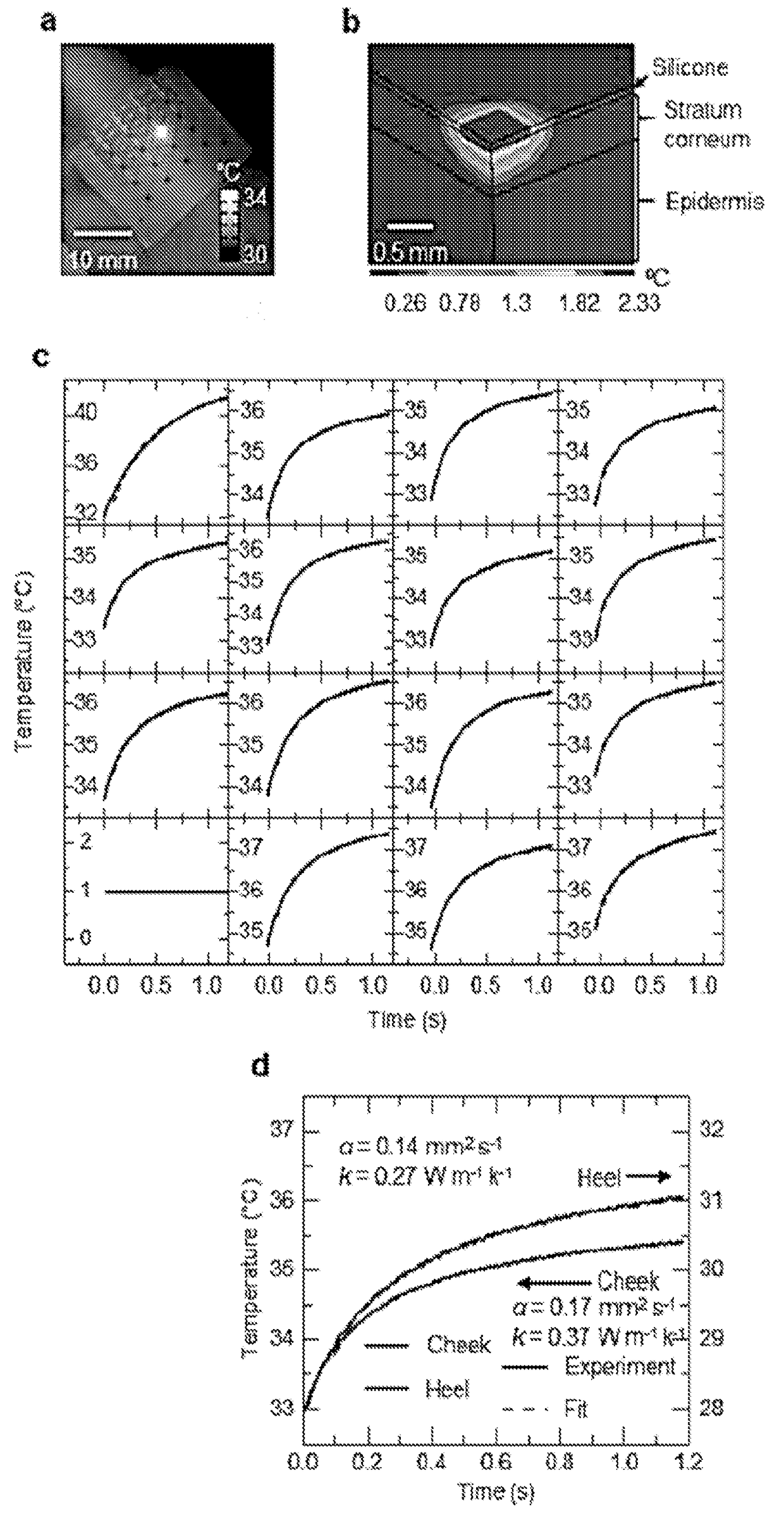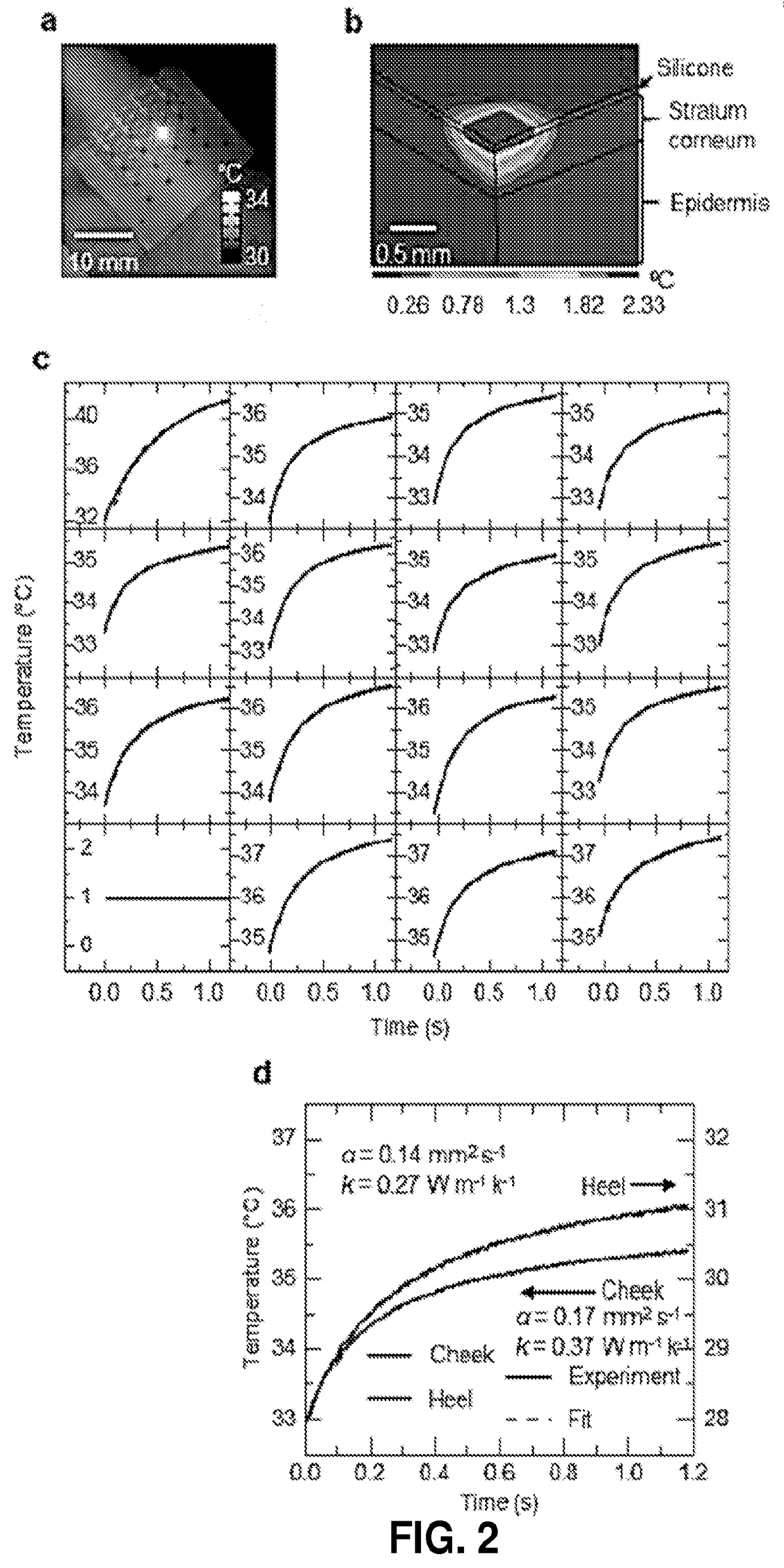Thermal Transport Characteristics of Human Skin Measured In Vivo Using Thermal Elements
a technology of thermal elements and human skin, which is applied in the field of thermal transport characteristics of human skin measured in vivo using thermal elements, can solve the problems of inability to accurately measure the temperature of the skin, etc., to achieve the effect of reducing the effect of ambient temperature fluctuation
- Summary
- Abstract
- Description
- Claims
- Application Information
AI Technical Summary
Benefits of technology
Problems solved by technology
Method used
Image
Examples
example 1
ransport Characteristics of Human Skin Measured In Vivo Using Ultrathin Conformal Arrays of Thermal Sensors and Actuators
[0134]Measurements of the thermal transport properties of the skin can reveal changes in physical and chemical states of relevance to dermatological health, skin structure and activity, thermoregulation and other aspects of human physiology. Existing methods for in vivo evaluations demand complex systems for laser heating and infrared thermography, or they require rigid, invasive probes; neither can apply to arbitrary regions of the body, offers modes for rapid spatial mapping, or enables continuous monitoring outside of laboratory settings. Here we describe human clinical studies using mechanically soft arrays of thermal actuators and sensors that laminate onto the skin to provide rapid, quantitative in vivo determination of both the thermal conductivity and thermal diffusivity, in a completely non-invasive manner. Comprehensive analysis of measurements on six di...
example 2
Studies of Thermal Transport Characteristics of Human Skin Measured In Vivo Using Ultrathin Conformal Arrays of Thermal Sensors and Actuators
[0234]Study Details:
[0235]Patients: 10 women, aged 18-30, and 10 women, aged 50-65.
[0236]Stimulus:
[0237]Glycerin (glycerine in water solution) of varying compositions from 0%-30% on randomized locations on patients' right volar forearm. Serves as humectant, which is a diffusion barrier to prevent transepidermal water loss (TEWL). [1]
[0238]Occlusive Patch:
[0239]Physical barrier preventing water from escaping from Stratum Corneum.
[0240]Measurements:
[0241]Transepidermal Water Loss (TEWL) (Commercial).
[0242]Corneometer (Commercial).
[0243]Epidermal thermal transport measurement.
[0244]Epidermal impedance measurement.
[0245]Time Points Legend:
[0246]T0 BPA=Before stimulus is applied (baseline)
[0247]TI mm=15 mins after stimulus is applied
[0248]T30=30 mins after stimulus is applied
[0249]T60=60 mins after stimulus is applied
[0250]T330=330 mins after stimul...
example 3
-Based Hydration Measurements
[0268]Measuring Principle:
[0269]The outermost skin layer, the stratum corneum, is typically between 15 μm-40 μm thick, and consists of mainly keratinized cells. Beneath the stratum corneum are the dermis and the epidermis, (roughly 100 μm and around 400 μm thick, respectively). The stratum corneum acts as a highly resistive layer, while the underlying layers, consisting of mainly granular cells, have a strong capacitive component to their impedance [1]. The application of an AC current to skin-mounted electrodes can be used to measure impedance, which corresponds strongly to hydration levels in the stratum corneum [3]. This forms the basis of traditional capacitive or impedance based techniques used to measure skin hydration levels [4]. Traditionally, concentric circular electrodes are employed, and the geometry and spacing of the electrodes strongly influences the measurement depth, with measurement depth approximated as roughly half the spacing between...
PUM
 Login to View More
Login to View More Abstract
Description
Claims
Application Information
 Login to View More
Login to View More - R&D
- Intellectual Property
- Life Sciences
- Materials
- Tech Scout
- Unparalleled Data Quality
- Higher Quality Content
- 60% Fewer Hallucinations
Browse by: Latest US Patents, China's latest patents, Technical Efficacy Thesaurus, Application Domain, Technology Topic, Popular Technical Reports.
© 2025 PatSnap. All rights reserved.Legal|Privacy policy|Modern Slavery Act Transparency Statement|Sitemap|About US| Contact US: help@patsnap.com



